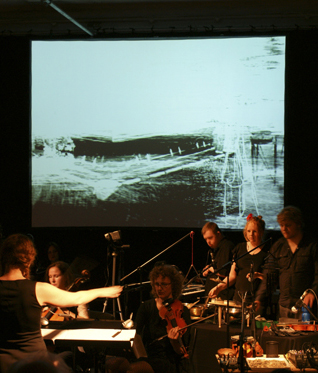scaling the heights to quality & equality
simon charles: the mountain concerts

Daniel Bond (Amplified Elephants), Tom Oaks and Annemeike Oaks (Noise Scavengers), Belinda Woods, Caerwen Martin, Andrea Keeble (BOLT Ensemble), The Mountain, The Click Clack Project
photo Matt Bonner
Daniel Bond (Amplified Elephants), Tom Oaks and Annemeike Oaks (Noise Scavengers), Belinda Woods, Caerwen Martin, Andrea Keeble (BOLT Ensemble), The Mountain, The Click Clack Project
THE MOUNTAIN EMBODIES AN AGENDA FOR SOCIAL EQUALITY. IT BRINGS TOGETHER ARTISTS WITH VARYING ABILITIES, FROM HIGHLY EXPERIENCED PROFESSIONAL MUSICIANS, TO THOSE WITH DISABILITIES OR FROM DISADVANTAGED BACKGROUNDS.
Artistic director James Hullick has striven to create work that equally values the contributions of all members, regardless of ability. In CD liner notes, Hullick writes, “If we are to accept that all people are equal as they walk amongst our vibrant community, then we must accept that the abilities of all people are of equal worth to our community.”
The Mountain brings together three ensembles: The Amplified Elephants, Noise Scavengers and the BOLT Ensemble. The Amplified Elephants are a group of musicians with intellectual disabilities, evolving through a program at the Footscray Community Arts Centre. Noise Scavengers is a group of young sound artists emerging from a similar program at Cloverdale Community Centre.
The BOLT Ensemble is a group of professional musicians, put together to perform original works by Hullick. As well as performing this role in the Mountain project, they have also helped in its development, working closely with musicians from The Amplified Elephants and Noise Scavengers to explore and discover new sounds.
The Mountain is a multi-movement work, using combinations of these three ensembles. It is based on Jetsun Milarepa, the story of a Buddhist saint who finds redemption through having to build a tower, then tear it down and repeat this process several times over. In this performance, Jetsun’s story is told through a series of scenes. The piece is not so much a programmatic depiction of the story but, instead, a series of abstract, contemplative moments derived from the narrative.
A plethora of sound sources are employed in this performance. These cover an entire spectrum of volume, from the subtle rustles of a prepared harp, blown bottles and delicately struck gongs, to loud, pulsating synths, no-input mixers and the grating sound of a tortured violin.
Given the varying ability of the musicians involved, Hullick’s approach to composition is dictated by the musicians’ capabilities. The role of composer is one of facilitation and the organisation of material. Hullick manages to breath life into this role by creating circumstances in which performers are free to delve into a playful engagement with sound. Despite this apparent freedom in performance, the overall work maintains focus and direction through variety of sonic ideas. What is perhaps most successful is the way sounds produced by non-professional players are integrated with those produced by professionals. This combination of sounds produced complexes of timbre that were detailed and intriguing.
Hullick’s compositions for the BOLT Ensemble seem to have recently developed a language that has greater command in the evolution of musical ideas over time. Rather than being a series of sound combinations that amble through a performance, there are different degrees of momentum and energy; musical structures that play with one’s perception of time.
Despite the complexity of Hullick’s musical structures, his aim for music to embody social equality is not lost. There is an inherent dialogue in the work in which all the voices of the players make a valuable contribution.
Visual images by Klara B Klaric and Tien Pham provide a useful way of delineating the various scenes. While the overall contribution was generally atmospheric, the graininess and roughness of the images complemented the music’s aesthetic, if at times distracting our sense of its evolution.
The Mountain takes the idea of ‘found sound’ in an entirely new direction. As well as turning unexpected objects into musical instruments, this work also finds unexpected performers. Just as found sounds are inherently intriguing, the manner in which musicians discover and engage with sound yields its own intrigue and idiosyncrasies. The risks in this work, taken for the sake of artistic ideals, have paid off with success. The Mountain Concerts have realised the ideal of social equality in performance, and not merely as the spectre of possibility.
The Mountain Concerts, by The Click Clack Project, featuring The Amplified Elephants, Noise Scavengers, BOLT Ensemble, presented by Footscray Community Arts Centre, Cloverdale Community Centre and JOLT Arts Inc; fortyfivedownstairs, Melbourne, Dec15-18, 2010
RealTime issue #101 Feb-March 2011 pg. 50






